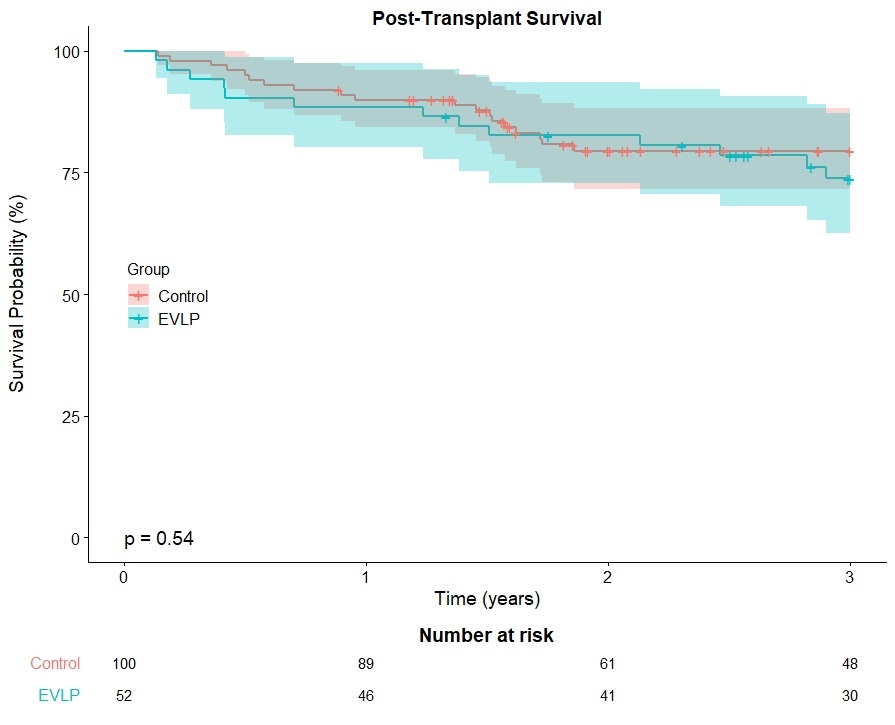Lung Transplantation After Ex Vivo Lung Perfusion, Early and Mid-Term Outcomes
Department of Cardiothoracic Surgery, University of Pittsburgh, Pittsburgh, PA
Meeting: 2022 American Transplant Congress
Abstract number: 334
Keywords: Lung transplantation, Machine preservation
Topic: Clinical Science » Lung » 64 - Lung: All Topics
Session Information
Session Name: Early and Late Outcomes in Lung Transplantation
Session Type: Rapid Fire Oral Abstract
Date: Monday, June 6, 2022
Session Time: 5:30pm-7:00pm
 Presentation Time: 5:40pm-5:50pm
Presentation Time: 5:40pm-5:50pm
Location: Hynes Room 210
*Purpose: The safety of lung transplantation using ex vivo lung perfusion (EVLP) has been confirmed by multiple clinical studies, however, limited evidence is currently available regarding the effect of EVLP on detailed posttransplant graft complications and survival with mid- to long-term follow-up. In this study, we reviewed our institutional data and compared the posttransplant course between patients who received lungs with and without EVLP evaluation.
*Methods: Lung transplant cases performed at our institution between 2014-2019 were reviewed and a retrospective analysis was performed regarding posttransplant clinical outcomes for both EVLP cases and controls (no EVLP use). Normothermic acellular EVLP was performed for marginal graft screening. Cases were matched on diagnosis, age, lung allocation score and additional clinical characteristics. Univariable data were analyzed with chi-square and Mann-Whitney U tests.
*Results: The analysis included 52 EVLP recipients and 100 matched controls. Incidence of severe primary graft dysfunction at 72 hours was significantly higher in the EVLP group (34.6%) compared to 20.0% in the control (p=0.048). Also, EVLP recipients had significantly longer durations of ICU stay (p=0.02), mechanical ventilation (p=0.04) and hospital stay (p=0.04) relative to controls. EVLP lungs exhibited anastomosis ischemia reperfusion injury >2 grade within 30 days posttransplant (77.1%) more significantly than control lungs (58.8%, p=0.03), while no marked difference of airway complications including dehiscence and stenosis was noted between the groups. There was a trend for lower rates of acute cellular rejection within 6 months after transplant in the EVLP group (51.9%) compared to the control group (68.0%, p=0.052). No difference was found on the onset of bronchiolitis obliterans syndrome grade 1 (EVLP: 4.9% and control: 14.8%, p=0.10) or grade 3 (EVLP: 4.9% and control: 1.2%, p=0.22) and there was no difference between groups in time-course of FEV changes (p=0.14). Finally, there were no differences in three-year survival between those who received EVLP lungs (73.8%) and controls (79.5%, p=0.54, Figure 1).
*Conclusions: Our institutional data showed EVLP use is associated with airway ischemia of anastomosis site, as well as longer durations of mechanical ventilation and hospital stay. In addition, the effect of EVLP preconditioning may be estimated as minimum on early acute graft rejection, however, functional outcomes following hospital stay, such as long-term survival, were not different between groups.
To cite this abstract in AMA style:
Noda K, Chan EG, Ryan J, Furukawa M, Luketich JD, Sanchez PG. Lung Transplantation After Ex Vivo Lung Perfusion, Early and Mid-Term Outcomes [abstract]. Am J Transplant. 2022; 22 (suppl 3). https://atcmeetingabstracts.com/abstract/lung-transplantation-after-ex-vivo-lung-perfusion-early-and-mid-term-outcomes/. Accessed December 14, 2025.« Back to 2022 American Transplant Congress

